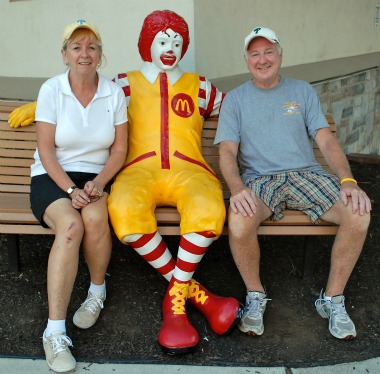When you’re used to cooking for thousands, dinner for a couple dozen people is no sweat. Okay, if you’re at the stove, maybe there’s a little sweat. But volunteers from the Philadelphia area’s Hibernian Hunger Project (HHP), a national charitable program of the Ancient Order of Hibernians, didn’t let a little heat drive them out of the kitchen.
On Monday, June 13, they prepared roast beef, mashed potatoes, baked chicken breasts, lasagna, eggplant parmagiana, various veggies, salad, and dessert for the children and families staying at the Ronald McDonald House on Erie Avenue, next to St. Christopher’s Hospital for Children.
Like the Hibernian Hunger Project, which feeds thousands of needy people around the country, the 300 Ronald McDonald Houses around the US trace their roots to Philadelphia and something Irish.
In 1974, a pediatric oncologist at The Children’s Hospital of Philadelphia, Audrey Evans, MD, met with Eagles General Manager Jimmy Murray whose team was raising funds to support a player whose daughter was being treated for leukemia at St. Chris’s. Murray reached out to McDonalds which offered the proceeds from the sales of its Shamrock Shake to build a place where families of children being treated at local medical facilities could stay. Children come from all over the country—in fact, all over the world—to Philadelphia which has three children’s hospitals—CHOP, St. Chris’s, and Shriner’s at Temple University.
The first Ronald McDonald House was carved from a seven-bedroom home on Spruce Street near CHOP and a brand new facility, with 18 guestrooms, opened in 2008 at St. Chris’s. It costs families $15 a night to stay at the Ronald McDonald House, unless they can’t pay. Then, it’s free.
As is much of the labor. There’s only a few paid staff and, though St. Chris’s house has a state-of-the-art kitchen that even Emeril would love, all meals are cooked and served by volunteers.
“I had no idea that all the food was donated,” said Donna Donnelly, who serves on the HHP Board, as she popped two trays of mashed potatoes in one of the ovens, alongside bubbling trays of seasoned chicken breasts. “I also didn’t realize that they had somebody different to cook for them every night. I can see where it would be a comfort, after a day of sitting by a child’s bedside, to come back and have a home-cooked meal.”
On the other side of the kitchen, Ed Costello and his wife, Pat, were slicing up the roasts that had been simmering in 50-gallon slow cookers of all day.
“This is making me hungry!” called another volunteer, sniffing the rich aroma perfuming the air.
At another oven, Kathy Gessler and Patty-Pat Koslowski were minding the lasagna, the eggplant parm, and the chicken gravy. “Pass me the cheese,” said Koslowski, who works for a caterer. “I need to put the finishing touches on this.”
The man who created the Hibernian Hunger Project, Bob Gessler, former president of AOH Div. 87, made the connection with the Ronald McDonald House last March, after he saw volunteers serving breakfast to families on St. Patrick’s Day. “I talked to them about having us come in and while we couldn’t do it on St. Patrick’s Day, we decided to do shamrocks for the staff and the families,” he explained. The potted “shamrocks”—actually oxalis plants—are still in all the kitchen windows.
A tribute to the staff’s ability to attract volunteer chefs, the next available time was in June.
Gessler saw the undertaking as a way to involve more people in HHP, which holds regular “cook-ins” during which they make up to 6,000 meals for the elderly and shut-ins served by Aid for Friends, a nonprofit organization in Northeast Philadelphia. All year long, local AOHs collect canned goods or raise money for HHP. They make and deliver food baskets at the holidays. “We’re always looking for ways to get more people connected to HHP,” says Gessler. While the cook-ins draw hundreds who work, assembly line style, preparing meals for freezing, volunteers rarely see the fruits of their labor—the smile on the face of someone savoring the meal.
“I saw this as something that’s on a smaller scale, something they can own,” he says. “People want to help. Sometimes they don’t know how to help. They don’t have to spend any money. We have the money. What we need are your time and talents.”
At 6 sharp, the receptionist at the front desk announced over the loud speaker: “Dinner is now being served by the Hibernian Hunger Project” and the first takers appeared in the dining room and got into the buffet line: staff members, moms, dads, grandparents, children wearing wrist tags identifying them as patients. The volunteers hung back, watching as the food was scooped and piled onto plates.
And, about 20 minutes into the meal, they got their reward. “They’re coming back for seconds!” whispered one. For a volunteer with the Hibernian Hunger Project, that’s equivalent to “my compliments to the chef.”
See the photos from the Hibernian Hunger Projects kitchen duty at the Ronald McDonald House.

